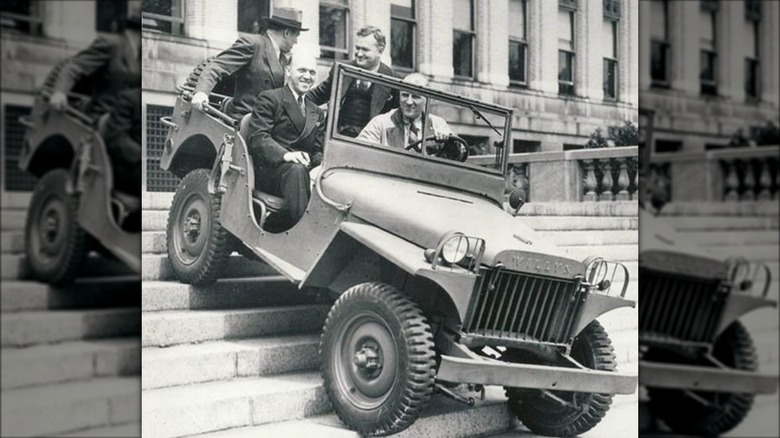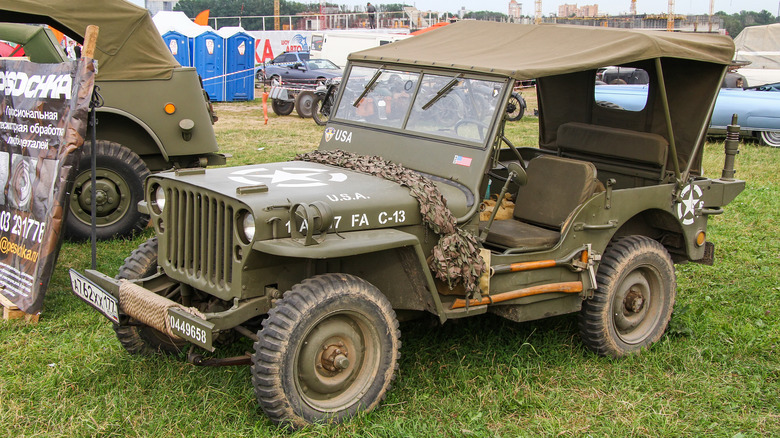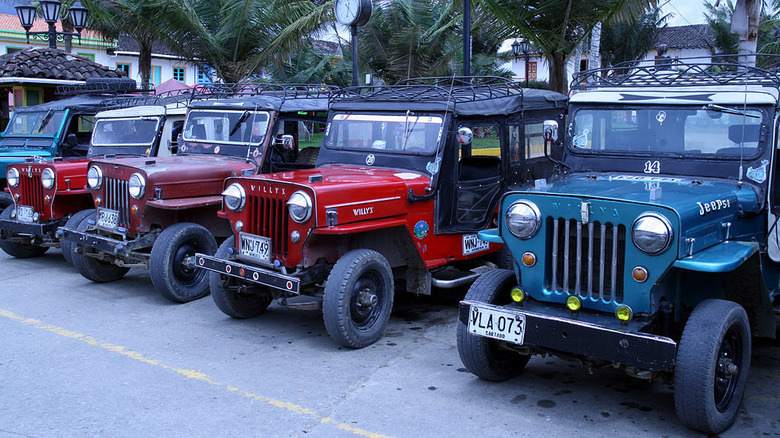Everything To Know About Flat Fender Willys Jeeps
Fenders are the protective shields that cover and frame the wheel wells on your car. They literally fend off unwanted dirt and debris that car tires kick up off the road. But what the heck is a flat fender — or Flatfender — on a Jeep?
Many changes have been made to Jeeps over the last eight decades, so the answer requires a lot of unpacking. However, the most straightforward answer is that a Jeep's flat fenders have thin angled sheet metal forming what appear to be flat, shelf-like mudguards above the front wheels. Meanwhile, the rear tub has body panels with cutouts for the back wheels.
Flat fenders also give additional clearance for bigger tires and improve approach angles in off-road scenarios. Many folks agree (while some would argue against the notion) that it's not a real Jeep without a flat fender. Despite where you might sit on that hotly debated topic, the first Willys flatties are the original Jeeps, and these golden oldies have experienced a renaissance among collectors.
In 1940, the U.S. Army sent a request for proposal to 135 automakers, asking them to build a general-purpose "light reconnaissance vehicle." It had to be a small 4x4 capable of hauling around a light machine gun that was quick, easy, and cheap to repair (with parts like thin metal fenders). Only three of the 135 manufacturers responded, including American Bantam, Willys-Overland, and Ford.
What's in a name?
Willys provided a prototype, of which only two were made, called a Quad. Bantam rolled out the Bantam Reconnaissance Command (or BRC-40). Then Ford provided a Model GP. And, much like a 4x4 rolling through muddy waters (of confusion), all three would collectively become known as the generic term for the thing we call a "jeep." If you're wondering — yes, all these are considered flat fenders (also called flatties).
Many think the Jeep name came from the slurring of the acronym "GP," which stood for "General Purpose" or where the "G" was Ford's designator for a government contract vehicle and the "P" denoted the short 80-inch wheelbase. However, the term actually existed during World War I and was used to describe either an untested recruit or a vehicle. Additionally, there was a character named Eugene the Jeep, who was the pet of popular comic strip character, Popeye the Sailor in the 1930s.
Then, in February 1941, we have the first documented use of the term. During a press event, Willys drove one of the two Quad prototypes it had built up the steps of the Capitol in Washington, D.C. When asked by a reporter what the vehicle was called, the driver said, "It's a jeep." The next day the front page of the Washington Daily News read "Jeep Creeps Up Capitol Steps." The rest is history. In the case of Willys and Jeep, however, it's truly appropriate.
[Featured image by Unnamed via Wikimedia Commons | Cropped and scaled | CC BY Public Domain]
Jeep flatties were a soldier's best friend
Willys won the primary U.S. Army contract and started with the MAs in 1941 as the production version of the prototype Quad. It made fewer than 1,600, with most being sent overseas through a lend-leased program Russia and England used during World War II. Only 30 original MAs are believed to still exist, making it the rarest in the Willys family.
The company quickly shifted to the MB (Military Model B), produced between 1941 and 1945, which became the first four-wheel drive vehicle in the world produced in large quantities. It also became a de facto symbol of the U.S. Army and an invaluable piece of kit to virtually every WWII soldier, all of which helped build the Jeep empire we know today.
Ford lent help to keep up with production, building the GPW under the Willys license (thus the "W"), and Bantam eventually faded away. In 1940, under 100 "jeeps" existed. By 1941, the three carmakers built nearly 8,500 "jeeps" between them. Between 1940 and 1945, Willys made roughly 363,000 versions of its jeep, while Ford made approximately 280,000. And yes, all 643,000 and more were flatties.
The first mass-produced civilian-branded Jeep followed in the CJ-2A (1945-1949). The company heavily marketed it as a "universal" workhorse for both the agricultural and industrial segments of post-war America. The original MSRP was $1,090. You guessed it, another flattie.
Jeeps here, Jeeps there, Jeeps everywhere!
Willys-Overland tried trademarking the "Jeep" name in '43. However, it took several years of considerable legal wrangling before winning the name in 1950. Three years later, Henry J. Kaiser purchased the company for $60.8 million, becoming Willys Motors Inc. During the 16 years Kaiser owned them, Jeep manufacturing facilities opened in 30 foreign countries, and the brand went global.
CJs were also flatties, as was the Willys wagon (its all-steel take on the "Woody" of the day) and its truck made between 1946 and 1965. The CJ line extended to the CJ-8 Scrambler in 1985, but not all of those are considered flatties. In 1950, the first post-WWII military Jeep-branded flattie known as the M38 (the Willys Model MC) rolled out.
Between 1941 and 1965, all flat fenders (minus the CJ-3B) were powered by a flathead four-cylinder, with minor differences scattered across the innumerable models.
The "Universal" CJ-3B sold between 1953 and 1968, making it the longest production run for any Jeep model, while the DJ-3A (1959 to 1964) was used primarily on resort properties. Both are considered flat fenders. Even foreign divisions banged out "flatties" of their own as late as 1998. Still, hardliners believe the last true flat fenders rolled off the production floor at the original plant in Toledo, Ohio, way back in 1952.
[Featured image by Remi Jouan via Wikimedia Commons | Cropped and scaled | CC BY-SA 3.0]



